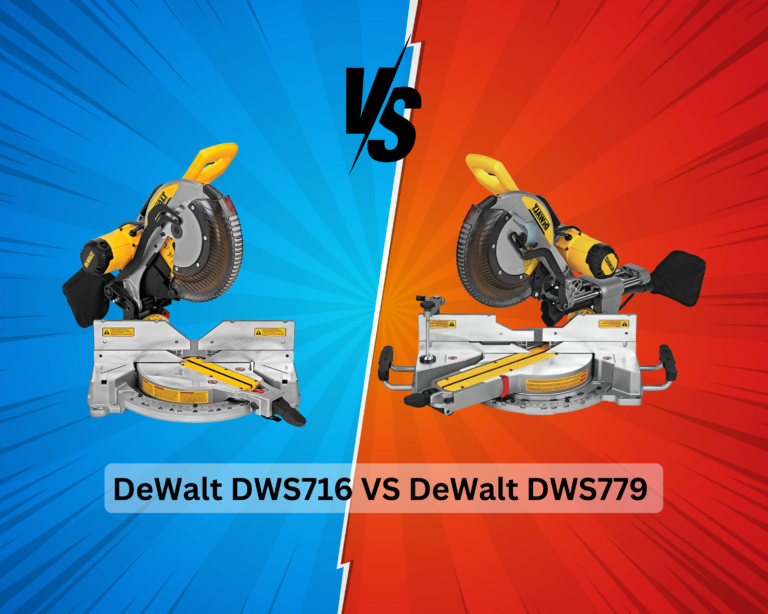Circular Saw vs Track Saw – Which One Should I Choose?
As an Amazon Associate I earn from qualifying purchases.
The circular and tracksaw are very efficient, have almost the same look, and make the same cuts. However, due to differences in features and functions, one receives more benefits than the other.
A track saw uses a track rail and riving knife to make long, straight cuts with great accuracy and no visible tear-out, resulting in smooth, clean cuts.
In contrast, a circular saw is a versatile tool to make different cuts on both thin and deep materials, provides freedom of movement, and is more affordable.
Let’s get the detailed description and other aspects of the Circular saw vs Track saw.
Contents
Comparison Table between Track saw and Circular saw
| Features | Circular saw | Track saw |
| Speed | Faster | fast |
| Blade type | Circular blades | Circular blade |
| Main purpose | Straight line and plunge cut | Long straight cuts |
| Power supply | Corded and cordless | Corded and cordless |
| Cut quality | Less smooth | Smooth |
| Straight cut | Less accurate | Accurate |
| Deep cut | Deeper | Less deep |
| Weight | More | Less |
| Safety | Average | Better |
| Portable | Yes | Yes |
| Price | Affordable | Costly |
Pros and Cons compared to Circular saw and Track saw
Circular saw
A Circular saw is a powerful hand-power tool that uses circular blades to make free straight, rip, bevel, and plunge cuts on a thin and thick piece of materials and costs less than a track saw.
It is portable and available in both corded and cordless versions, allowing you to work anywhere.
Track saw
Unlike the circular saw, a track saw uses a rectangular track that supports it to make very long straight cuts with great accuracy and ensure smooth and clean finish cuts.
This Plunge saw has a dust port, is much safer, portable, and available in both corded and cordless versions, allowing you to work anywhere.
Differences between Track saw and Circular saw
Structure
For the compact and enclosed structure, a track saw is more safer than a circular saw as a circular saw blade is more exposed. For the housing of a track saw, its blade is less visible to provide more protection.
Size and weight
A circular saw weighs more and size bigger than a track saw. For bigger sizes, they required more space to operate and were tough to carry. Also, there are small sizes of circular saws available; you can purchase those if you have space problems, but getting the smaller size, you have to compromise the cutting depth.
Power and Speed
Typically a circular saw has more power which rotates the blade faster than a track saw to cut faster. But depending on the blade size, the rotation speed can differ on a circular saw. As the small size blades rotate fast and bigger size blades rotate slow.
Blade
Both the track saw and circular saw uses circular blades. But the blade size differs from each other. A circular saw uses different sizes and bigger blades and can be up to 10.25 inches long. In contrast, a track saw uses 6.5-inch diameter circular blades.
Depth cut
You have to raise or lower the base plate to set the depth of the circular saw, whereas a track saw has a dedicated slot to set the depth. The bigger blades of a circular saw at 90° can make cuts up to 3-13/16 in. deep.
In comparison, a track saw can’t cut more than 2 or 3 inches deep for smaller blades.
Thin woodcuts
A circular saw can make a cut on very thin pieces of wood easily. Though a track saw cuts thick pieces of wood very well, cutting thin pieces of wood is tough on it.
Usage
Both the circular saw and track saw can make the same cuts like straight, rip, cross, bevel, and angle cuts, but the track saw ensure very straight and accurate cuts, and they are more preferable for long and short cuts for their track rail.
But the cut-like plunge cut will be more accurate and preferred with a circular saw.
Cuts
Both saw can cut materials such as hardwood, softwood, steel, masonry, and ceramic tile. But I got that the circular saw performs better on construction work. In comparison, a track saw can perform better in construction and furniture work.
Track support
The track saw uses a rectangular track rail to ensure better support on every cut. You just have to attach the track saw and slide it on the track to have excellent long cuts.
In contrast, a circular saw doesn’t have a track, it only has a base plate, and based on it, you have to control the circular saw to have excellent cuts. However, you can cut like a circular saw by ditching a track saw.
Note: There are tracks available in the market for a circular saw that you can attach and have the advantage of a track saw.
Riving knife or kickback
A track saw comes with a riving knife that reduces kickback while cutting. In contrast, on a less grip, a circular kickback while cutting for the lacking of a riving knife. Which can damage your workpiece and make it less safe than a track saw.
Dust collection
A track saw has a dust port where you can attach a shop vac to collect the dust. Actually, the enclosed housing allows it to collect dust more easily. However, in a circular saw, you don’t get any dust port or bag to collect dust, which messes up your workshop while cutting.
Portable
Both saw comes in corded and cordless versions for inside and outside usage. Though a circular saw is weight heavy, it has more portability than a track saw, as you just have to carry the circular saw.
In comparison, you have to carry the track rail along with the track saw, but it can be portable in your workplace.
Versatile
A circular saw is more versatile than a track saw as it can make cuts on thin and thick pieces of wood and is more portable than a track saw.
Accuracy
A track saw is more accurate than a circular saw as it has a track rail that grips the cutting surface very well, and by sliding it on the track, you will get fast, accurate, smooth, and clean cuts.
Price
Comparing different brands and models, I got that the circular saw is much cheaper and more affordable than the track saw. Spending around $150, you will get a good quality circular saw.
In comparison, spending around $400 to $500, you will get a good quality track saw.
Which one should I choose; Circular saw or Track saw
As for my usage, if you have a budget, you should choose a track saw because a track saw has a track rail that grips the surface well to ensure better cut accuracy. Also, following that track, you can cut long sheets to make them into smaller pieces and cut a straight edge on irregular boards clean and smooth.
It has a riving knife, an enclosed structure, and a dust port to make it more safer to use and keep your workplace clean.
In comparison, if you have a tight budget and need a versatile saw to make different cuts on thin and thick workpieces. Then you can choose a circular saw. But you must remember that you don’t get a track rail with it; you must depend on your skill to control a circular saw to make perfect cuts.
However, a track saw can be used as a circular saw to have all the advantages a circular saw has, which makes a track saw an easy replacement for a circular saw.
Note: Even a track saw can replace a table saw, miter saw, and circular saw; for that, it is worth it to purchase a track at that cost.
Frequently Asked Questions
Can I use a Makita Circular saw with a track?
Yes, Makita Circular saw is compatible with a track. Different tracks are available on the market for a circular saw, or you can make a custom track to attach to support long, straight, and accurate cuts.
Are more teeth on a circular saw blade better?
More teeth on a circular saw blade are always better as for more teeth, you get a smooth and fine finish while cutting, but one thing you have to compromise is speed because the more teeth blade you select, the slower speed you will get.
What should you not do with a circular saw?
There are certain things you should avoid while cutting with a circular saw. 1. Do not adjust the guard or bevel saw while running, 2. Never put your hand front, back, or under the saw, 3. Don’t pull off the saw while the blade is spinning, 4. Finally, only start cutting with proper support or gripping the workpiece.
Do you Push or pull a Track saw?
You have to push a track saw to cut. A track saw blade moves upward, and while the track lays on the surface, attach the track saw and, following the track, push it forward.
Like the track saw, push the circular and miter saw to cut.
Conclusion
A circular saw is more versatile for cutting different thin and thick pieces of materials at an affordable cost. In contrast, a track saw has a track rail to ensure more accurate and smooth long cuts.
Nevertheless, I have described all their capabilities, working perspectives, and usage. Now choose one that is appropriate for your work, budget, and space. Thank you.





